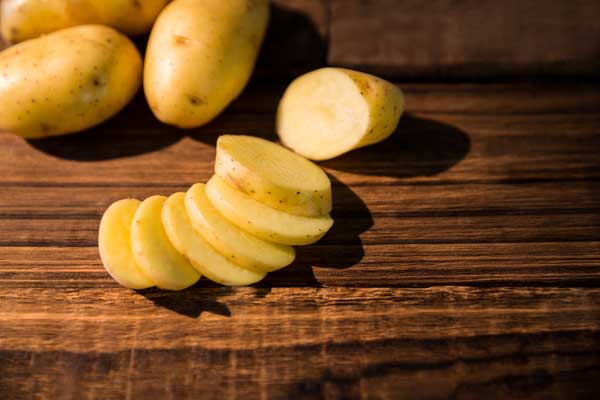There is a carb more deadly and dangerous than actual sugar that you need to know about. Unfortunately, you have likely been consuming this carb for a long time without realizing it. This ingredient is conflicting because it causes belly fat, diabetes and gut inflammation yet it is considered safe. How could that be? This doesn’t make sense.
This carbohydrate is not a sugar and not sweet, yet it behaves like sugar – even worse than sugar on the glycemic index. Looking at the glycemic index, table sugar ranks at 65 while glucose ranks at 100 since it is pure sugar. The reason glucose ranks higher is that table sugar contains both glucose and fructose, so it averages out to 65 on the index. However, this mystery ingredient ranks extremely high on the glycemic index between 110 to 136, even higher than glucose!

Can you guess what this invisible danger is? Comment below with your guess. Here are some clues: it’s found in chips, crackers, bread, pasta, cereals, infant formulas, soups, salad dressings, light beer, energy drinks, sports electrolyte products, protein powders, artificial sweeteners, sugar-free products, seasoning mixes, condiments, and flavorings. Its main purpose is as a filler ingredient.
The hidden danger is maltodextrin! Other names for maltodextrin include dextrin, modified food starch, glucose syrup, and corn syrup. Maltodextrin is a highly processed polysaccharide, meaning it is composed of many sugar molecules chained together. It is processed from starchy foods like corn and wheat using a process called hydrolysis which splits the long starch molecules into smaller pieces.
Legally, maltodextrin can still be classified as a starch even though it is refined and processed. Companies use this as a loophole to classify it as a carb instead of a sugar, even though it spikes blood sugar more than plain sugar! They can even classify it as zero carbs if a tiny serving size contains less than 0.5 grams. What a scam for people trying to avoid carbs and sugar!
When consumed, maltodextrin spikes blood sugar more severely than regular sugar and wreaks havoc on the digestive system. It causes inflammation, gas, bloating, and can alter the microbiome balance. There are even reports it contributes to leaky gut syndrome. Beyond digestive issues, it promotes weight gain, fatty liver disease, and insulin resistance like sugar.
Another loophole used by the food industry is that maltodextrin is classified as “Generally Recognized as Safe” or GRAS. This lets manufacturers bypass extensive FDA approval and claim it is safe based on industry research rather than rigorous scientific review. This is how many questionable ingredients get into the food supply without oversight.
The main problem is maltodextrin hides in so many grocery store foods. It is vital to start reading ingredient labels carefully and watch out for maltodextrin or any derivatives like dextrin, modified food starch, glucose syrup, and corn syrup. For health and weight loss, maltodextrin is one of the worst food additives to avoid.
Due to algorithm censorship online, finding truthful health information is increasingly difficult. To access all of my content, visit my website DrBerg.com and subscribe to my newsletter using the link below this video. See you on the other side with the real information!
What is Maltodextrin?
Maltodextrin is a highly processed powder that is often added to foods to improve texture, shelf life, or fiber content. It is derived from starchy foods like corn, potato, rice or wheat by using acids, enzymes or other processes to break down the starches into smaller carbohydrates.
The FDA classifies maltodextrin as a polysaccharide, meaning it contains multiple sugar molecules linked together. However, due to its refined nature, it acts very similarly to glucose and table sugar in the body.
Maltodextrin has an extremely high glycemic index, ranging from 110-136. This means it can spike blood sugar more aggressively than regular sugar which ranks at 65 on the glycemic index.
Health Dangers of Consuming Maltodextrin
Despite being classified as generally safe by the FDA, maltodextrin consumption is linked to numerous health issues:
- Digestive Problems: maltodextrin can cause digestive distress like gas, bloating, changes in bowel habits, and stomach pain in sensitive individuals. There are concerns it may promote leaky gut syndrome.
- Blood Sugar Spikes: the high glycemic index means maltodextrin can rapidly spike blood glucose and insulin. This leads to energy crashes, food cravings, and increased diabetes risk.
- Obesity: research connects high maltodextrin intake to weight gain, fatty liver disease, and insulin resistance. The blood sugar spikes promote fat storage.
- Inflammation: refined carbohydrates like maltodextrin trigger inflammatory pathways in the body. Chronic inflammation is tied to almost every modern health condition.
- Microbiome Disruption: overconsumption of maltodextrin appears to reduce microbiome diversity and encourage overgrowth of harmful bacteria species. This can create a negative feedback loop.
Sources of Maltodextrin in the Food Supply
Maltodextrin is found in a huge variety of processed convenience foods and condiments, including:
- Baked goods like breads, cookies, crackers, chips, pretzels, and cereals
- Sauces and dressings like ketchup, barbecue sauce, salad dressings
- Sweetened yogurts, ice creams, and protein powders
- Flavored beverages including soft drinks, energy drinks, instant coffee, beer
- Canned fruits, vegetables, soups, broths, and gravies
- Packaged meals like frozen pizzas, microwave dinners, instant oatmeal
- Candy, desserts, and sugar-free products sweetened with artificial sweeteners
- Pharmaceuticals, vitamins, nutritional supplements
Essentially, maltodextrin can be used as a filler, binder, emulsifier, or sweetener inprocessed foods. It is inexpensive, shelf-stable, and versatile.
How to Avoid Maltodextrin
Reading ingredient labels carefully is the only sure way to detect sources of maltodextrin. Watch for:
- Maltodextrin
- Dextrin
- Modified food starch
- Corn syrup
- Corn starch
- Glucose syrup
Avoiding processed convenience foods as much as possible limits maltodextrin consumption. Focus on fresh whole foods that don’t contain additives or refined carbohydrates.
If choosing packaged products, opt for ones with short ingredient lists that stick to whole food ingredients you recognize. Going for certified organic products also minimizes exposure to hidden additives like maltodextrin.
Making more real food meals at home lets you control exactly what goes into your diet. Avoiding maltodextrin by reading labels, prioritizing whole foods, and cooking at home protects your health.
Conclusion
Maltodextrin is a highly refined additive hiding in numerous grocery store foods. Despite being classified as safe, it can wreak havoc on metabolic health by spiking blood sugar, causing weight gain, disrupting the gut microbiome, and triggering inflammation.
To protect your health, start reading ingredient labels carefully and avoid products containing maltodextrin and its derivative ingredients. Focus on eating fresh, whole foods as much as possible instead of packaged convenience items loaded with additives like maltodextrin. Though it takes more effort, avoiding this additive provides big benefits for your health and waistline.
